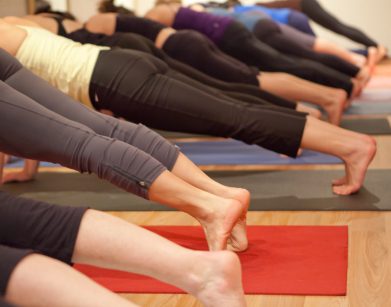5 plank variations to keep you engaged
Challenge your core and keep your mind busy with these five variations on basic plank pose

Source: Web exclusive, September 2011
Doing a plank exercise challenges your entire core, but when you get too good at it’or you’re no longer motivated to do it’it might be time to kick your efforts up a notch.
If you can comfortably hold a bent-leg plank (balanced on your forearms and knees) for about 30 seconds, try advancing to your forearms and toes with legs straight.
Already doing that? Check out our five plank variations below for engaging your core and your interest.
5 plank variations
Try these moves when you can hold a straight-leg plank for about 30 seconds while keeping good form (i.e., neutral spine, hips level and shoulder blades slightly retracted). You should feel challenged but ready to tackle a new level.
1. Add upward movement
While balancing in a plank position on your forearms and toes, lift your right foot off the floor, holding your leg about 12 inches above the floor for three to five seconds. Return right toes to floor and repeat on left side. Avoid tilting your hip upward as you raise your leg. Alternate legs, doing 12 to 16 reps total.
2. Add downward movement
From a plank with legs straight and core engaged, slowly bend your right leg, lowering your right knee toward the floor without touching. Hold for one to two seconds then return to starting position. Repeat on left side. Avoid tilting your hip downward as you lower the knee. Alternate sides, doing 12 to 16 reps total.
3. Turn it sideways
The side-lying plank is a good variation for targeting the sides of your abs. It looks like a regular plank, but turned on its side. Here’s how to do it: Lie on your right side, propped up on your right forearm, arm bent to 90 degrees and elbow aligned under shoulder. Lift your right hip off the floor and balance on the side of your right knee with legs bent (moderate level) or the side of your right foot with legs straight (advanced level). Hold for 10 to 30 seconds; switch sides.
4. Balance arms on stability ball or Bosu ball
The wobble factor that either a stability or Bosu ball provides helps intensify an old familiar plank. With a ball, your entire body is more engaged to help you maintain balance and good form. To try it, place your forearms on top of the ball with either knees or toes on the floor. Avoid arching the lower back. Hold plank with good form for 10 to 30 seconds.
5. Balance legs on stability ball or Bosu ball
This exercise is effective for the same reasons described above, but it creates a different ‘feel’ to place the ball under your legs or feet. Balance your shins (moderate) or feet/toes (advanced) on the ball with arms straight and hands on floor, shoulder-width apart and elbows slightly bent. Avoid arching the lower back. Hold plank with good form for 10 to 30 seconds.
New to the Best Health Challenge? Click through to meet our featured participant, Kelly Mathews.




